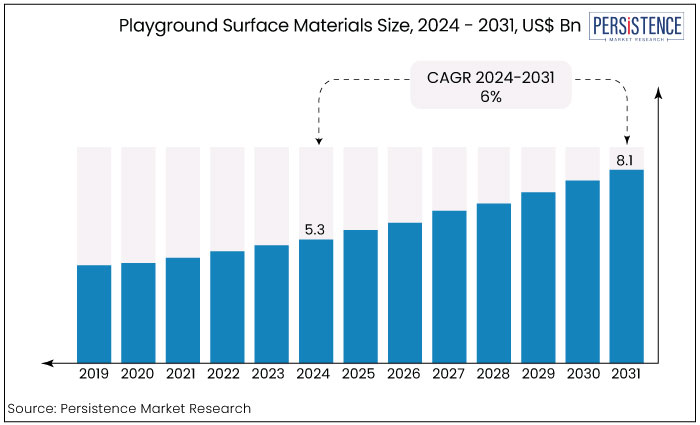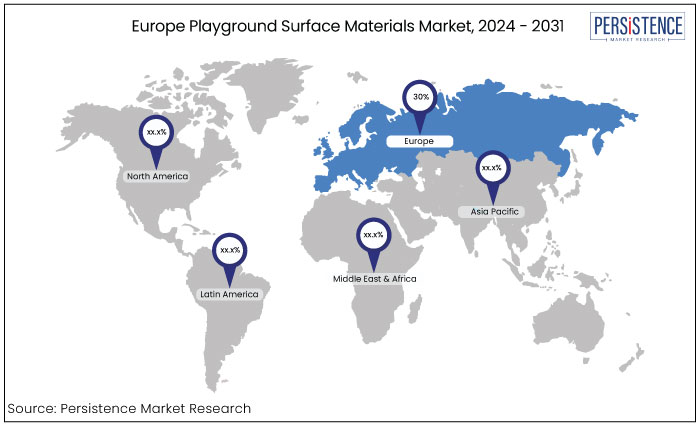Industry: Chemicals and Materials
Published Date: November-2024
Format: PPT*, PDF, EXCEL
Delivery Timelines: Contact Sales
Number of Pages: 172
Report ID: PMRREP26002
The playground surface materials market is estimated to increase from US$ 5.3 Bn in 2024 to US$ 8.1 Bn by 2031. The market is projected to record a CAGR of 6% during the forecast period from 2024 to 2031.
Both parents and governments are expected to realize the importance of physical activity in promoting a child’s physical, social, and mental development. It has augmented investments in multifunctional, interactive, and safe play surfaces to help support a child’s motor skills.
Residential complexes, parks, and schools are anticipated to incorporate synthetic turf and poured rubber flooring to deliver stimulating indoor and outdoor environments. In October 2024, for instance, Kids Empire, a new indoor play park, opened at the Oak Park Commons shopping center located in Lenexa. The park includes a turf soccer field, slides, climbing features, building blocks, and obstacle courses. It also offers spaces on rent to throw birthday parties. At the same time, it houses a souvenir shop and a snack bar. Similar park developments are anticipated to bolster demand for playground surface materials.

Key Highlights of the Market
|
Market Attributes |
Key Insights |
|
Playground Surface Materials Market Size (2024E) |
US$ 5.3 Bn |
|
Projected Market Value (2031F) |
US$ 8.1 Bn |
|
Global Market Growth Rate (CAGR 2024 to 2031) |
6% |
|
Historical Market Growth Rate (CAGR 2019 to 2023) |
2.8% |
|
Region |
Market Share in 2024 |
|
Europe |
30% |
Europe is projected to account for 30% of the global playground surface materials market share in 2024, driven by the region's emphasis on safety, sustainability, and inclusivity. Its strong focus on green infrastructure has also accelerated the use of recycled rubber, organic mulch, and cork-based surfaces. These help companies in aligning with the European Union’s (EU) sustainability goals.
Investments in inclusive playgrounds that cater to children with disabilities are also fueling demand for Americans with Disabilities Act Standards for Accessible Design (ADA)-compliant, soft-surface materials. With high awareness and steady infrastructure funding, Europe is set to sustain its significant market share.

|
Category |
Market Share in 2024 |
|
Site- Outdoor |
70% |
The outdoor site segment is projected to account for 70% of the market share, making it the largest contributor to the soft outdoor playground flooring market industry. This dominance is set to be driven by the rapid development of public parks, school playgrounds, recreational areas, and community spaces, which require durable, weather-resistant surfaces.
Materials like poured-in-place rubber, synthetic turf, and recycled rubber mulch are widely used outdoors. This is due to their ability to withstand UV exposure, temperature fluctuations, and heavy foot traffic. Several urban areas are focusing on outdoor recreational infrastructure to promote physical activities and community engagement. Governments and municipalities are investing in inclusive and eco-friendly playgrounds, further propelling demand for cutting-edge outdoor surface solutions. For instance,
Similar projects are anticipated to augment the need for unique playground materials in the forecast period.
|
Category |
Market Share in 2024 |
|
End User - Commercial |
65.6% |
The commercial segment remains the dominant end user, boosting the playground surface materials market growth. It is set to be driven by rising investments by urban parks, schools, recreational centers, resorts, and shopping malls in high-quality, durable surfaces. Municipal bodies and private developers are prioritizing safety-compliant, low-maintenance materials. They are mainly utilizing poured-in-place rubber, synthetic turf, and interlocking tiles to meet stringent regulatory standards.
The rise of public-private partnerships for developing inclusive and eco-friendly playgrounds further strengthens the commercial segment's position. With growing emphasis on community spaces and child-friendly infrastructure, demand for unique, sustainable surface solutions is likely to surge over the forecast period. For instance,
The playground surface materials industry is experiencing robust growth, driven by increasing investments in safe and accessible recreational spaces for children. As urban areas broaden, there is a rising demand for durable and eco-friendly surfaces.
Advancements in technology are further leading to innovations in material durability and maintenance, making surfaces more resilient against weather conditions and heavy usage. Collaborations between public and private sectors are further bolstering investments in playground infrastructure, ensuring a strong outlook for market expansion in the coming years. For instance,
Rising focus of companies on safety, sustainability, and inclusivity is hence shaping the future of the market.
The playground surface materials market expanded at a CAGR of 2.8% during the period from 2019 to 2023. This period witnessed moderate growth due to considerable investments in recreational infrastructure.
Rising safety standards and parental awareness regarding injury prevention also pushed growth. However, economic uncertainty, fluctuating budgets for public parks, and the COVID-19 pandemic led to delays in playground construction, particularly in 2020, further declining growth.
The playground surface materials industry is projected to rise at a CAGR of 6% during the period from 2024 to 2031 reflecting increased demand for safe, sustainable, and accessible play areas. Growth is also set to be driven by strict safety regulations, rising investments in urban recreational infrastructure, and a shift toward eco-friendly materials like recycled rubber and organic mulch.
Rising awareness of inclusive play areas for children with disabilities is further likely to boost demand for ADA-compliant surfaces. Innovations in durable, low-maintenance materials and partnerships with schools and municipalities are also expected to fuel market expansion.
Increasing International Sporting Events to Augment Demand
Increasing demand for both outdoor and indoor playing surfaces is set to be pushed by the growing emphasis on recreation, community interaction, and public health worldwide. The quality and quantity of sports facilities play a key role in promoting physical activity and social engagement.
Various materials, such as engineered wood fiber, pea gravel, sand, asphalt, and concrete, are commonly used in the construction of these playing surfaces. However, wood-based materials like engineered wood fiber, despite being widely used are now discarded for having comparatively high carbon emissions. It makes them less environmentally favorable than a few other alternatives.
Demand for playground flooring tiles, whether for indoor or outdoor use is expected to rise significantly in the coming years. This trend is largely fueled by the increasing number of international sporting events. These events not only showcase athletic excellence but also highlight the need for high-quality sports facilities to support professional and recreational activities. For instance,
Similar events are set to accelerate the need for the development and upgradation of playground surface materials to ensure durability, safety, and performance.
Several developing countries like India and China are currently focusing on providing easy access to education. It is resulting in the rapid development of new schools and upgradation of the existing ones. Materials like sand, synthetic turf, and rubber are gaining popularity to meet strict regulations and ensure child safety.
In India, Samagra Shiksha Abhiyan, for instance, focuses on offering better infrastructure like playgrounds and high-quality education in public schools. Several schools in the country are now utilizing artificial turf and Ethylene Propylene Diene Monomer (EPDM) rubber flooring to develop safe play areas. As the number of schools rises, new playground surface material demand is projected to skyrocket.
Environmental Concerns with Artificial Turf to Pose Challenges
Health-related concerns with the use of artificial turf playground surfaces pose one of the key challenges in the market, particularly for athletes. North America and Europe-based institutions have recently highlighted potential health risks associated with artificial turf, specifically focusing on the materials used in its production. For instance,
One of the key concerns is the environmental impact of the materials used in artificial turf, particularly petroleum-based products and recycled tires. These are commonly employed in the production process. While recycling tires for turf infill helps to keep them out of landfills, there are growing concerns about their impact on both human health and the environment.
Using rubber and asphalt on these surfaces may contribute to greenhouse gas emissions. Rubber used in the padding does not allow proper water absorption, which can prevent rainwater from seeping into the soil, especially if the underlying soil is compacted.
Key Players Focus on Adopting Recycled Materials to Reduce Emissions
The focus on recycling and utilizing recycled materials presents a significant opportunity in augmenting the playground surface materials market revenue. As sustainability becomes a global priority, key participants are increasingly integrating recycled materials into production to align with environmental goals. This trend not only helps reduce the carbon footprint but also supports the shift toward a circular economy. It helps in ensuring long-term viability for businesses in this industry.
Manufacturers can differentiate themselves in a competitive market while contributing to environmental sustainability by investing in recycling technologies. For instance, Germany-based Sport Group signed a letter of intent with GBN-AGR in September 2021 to collaborate on developing artificial grass recycling infrastructure and technology across Europe. This partnership highlights the rising emphasis on recycling as a key strategy for the future.
Companies like AVG and Tarkett S.A. are also leading the way in sustainable innovation. In May 2021, AVG, based in Prague, installed 100% recyclable woven-back turf in China’s New Oriental sports field. It marked a step forward in eco-friendly product development. Paris-based Tarkett S.A. has also prioritized the creation of sustainable and recyclable products, particularly focusing on reducing carbon emissions in North America and Europe.
The playground surface materials industry is competitive, with a mix of global manufacturers, regional players, and specialized providers. They offer a wide range of solutions such as rubber tiles, synthetic turf, poured-in-place rubber, and organic mulch. Key strategies revolve around product innovation, sustainability, partnerships with urban planners and municipalities, and compliance with safety standards.
Recent Industry Developments
|
Attributes |
Details |
|
Forecast Period |
2024 to 2031 |
|
Historical Data Available for |
2019 to 2023 |
|
Market Analysis |
US$ Million for Value |
|
Key Regions Covered |
|
|
Key Market Segments Covered |
|
|
Key Companies Profiled |
|
|
Report Coverage |
|
|
Customization & Pricing |
Available upon request |
By Material Type
By Site
By End User
By Region
To know more about delivery timeline for this report Contact Sales

It is estimated to increase from US$ 5.3 Bn in 2024 to US$ 8.1 Bn by 2031.
CCGrass, Tarkett S.A., TenCate, Hellas Construction, and PlayCore, Inc. are some of the leading manufacturers.
It is projected to record a CAGR of 6% during the forecast period from 2024 to 2031.
Rubber surfacing is considered the best surface for playgrounds.
Kinetic sand is set to be ideal for playgrounds due to its lightweight, dust-free, and moldable features.